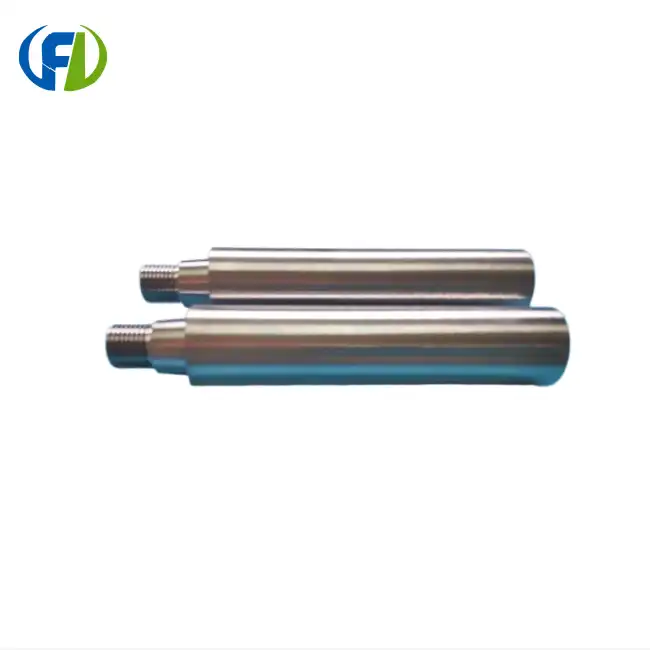Step-by-step Rolling Mill Process
The rolling mill process is at the heart of zirconium foil production. This multi-stage operation transforms zirconium ingots into thin, uniform sheets with precise dimensions and properties. Let's explore the key steps involved:
Hot Rolling
The process begins with hot rolling, where zirconium ingots are heated to temperatures between 800-1000°C. This elevated temperature softens the metal, making it more malleable and easier to shape. The heated ingots are then passed through a series of heavy-duty rolling mills. Each pass reduces the thickness of the material while elongating it. Hot rolling not only reduces the ingot's thickness but also helps break down the cast structure, resulting in a more uniform grain structure.
Intermediate Annealing
After hot rolling, the zirconium undergoes intermediate annealing. This heat treatment process helps relieve internal stresses built up during rolling and restore ductility to the material. Annealing is typically carried out in vacuum or inert atmosphere furnaces to prevent oxidation of the zirconium surface.
Cold Rolling
Following annealing, the zirconium sheets enter the cold rolling phase. Unlike hot rolling, cold rolling is performed at room temperature. The material is passed through precision rolling mills that apply high pressure to further reduce its thickness. Cold rolling not only reduces thickness but also enhances the mechanical properties of the zirconium foil, including increased strength and improved surface finish.
Final Annealing
The cold-rolled zirconium foil undergoes a final annealing process. This step helps achieve the desired combination of strength and ductility in the finished product. The annealing parameters, including temperature and duration, are carefully controlled to attain the specific properties required for different applications of zirconium foil.
Quality Control During Foil Production
Maintaining consistent quality throughout the zirconium foil production process is paramount. Rigorous quality control measures are implemented at every stage to ensure the final product meets the stringent requirements of various industries. Let's examine some key aspects of quality control in zirconium foil manufacturing:
Raw Material Inspection
Quality control begins with the careful selection and inspection of raw materials. The zirconium ingots used for foil production must meet strict purity standards. Advanced spectrometric techniques are employed to analyze the chemical composition of the ingots, ensuring they are free from impurities that could compromise the properties of the final foil.
Thickness Monitoring
Throughout the rolling process, the thickness of the zirconium sheet is continuously monitored. High-precision thickness gauges, often utilizing X-ray or beta radiation technology, provide real-time measurements. This allows operators to make immediate adjustments to the rolling parameters, ensuring the foil maintains a uniform thickness within tight tolerances.
Surface Inspection
The surface quality of zirconium foil is critical for many applications. Automated optical inspection systems are used to detect surface defects such as scratches, pits, or inclusions. These systems can identify imperfections as small as a few micrometers, ensuring only flawless foil reaches the end-user.
Mechanical Testing
Regular mechanical testing is conducted to verify the physical properties of the zirconium foil. This includes tensile strength tests, elongation measurements, and hardness testing. These tests ensure that the foil meets the required specifications for strength, ductility, and formability.
Energy Requirements for Manufacturing
The production of zirconium foil is an energy-intensive process, requiring significant power inputs at various stages. Understanding and optimizing these energy requirements is crucial for both economic and environmental considerations. Let's explore the major energy-consuming aspects of zirconium foil manufacturing:
Melting and Casting
The initial stage of zirconium processing, where raw zirconium is melted and cast into ingots, demands substantial energy. Electric arc furnaces or electron beam melting systems are typically used, consuming large amounts of electricity to achieve the high temperatures necessary for melting zirconium (around 1855°C).
Rolling Mill Operations
The rolling mills used in both hot and cold rolling stages are significant energy consumers. These powerful machines require substantial electrical energy to drive the rollers and apply the immense pressures needed to reduce the thickness of the zirconium sheets. The energy consumption during rolling can vary depending on the desired thickness reduction and the specific properties of the zirconium being processed.
Heat Treatment Processes
Annealing stages, crucial for achieving the desired microstructure and properties of the zirconium foil, also require considerable energy input. Vacuum or inert atmosphere furnaces used for annealing consume electricity to maintain precise temperature control over extended periods.
Auxiliary Systems
Beyond the core manufacturing processes, various auxiliary systems contribute to the overall energy footprint of zirconium foil production. These include material handling equipment, cooling systems for the rolling mills, and environmental control systems to maintain clean room conditions where necessary.
Energy Efficiency Measures
Given the high energy demands of zirconium foil production, manufacturers are increasingly focusing on energy efficiency measures. These may include the use of regenerative braking systems in rolling mills, heat recovery from annealing furnaces, and the implementation of advanced process control systems to optimize energy use across the production line.
The production of zirconium foil is a complex process that demands precision, expertise, and significant energy input. From the initial melting of zirconium ingots to the final rolling and annealing stages, each step is crucial in creating a product that meets the exacting standards required by industries ranging from aerospace to nuclear power. As technology advances, we can expect to see continued improvements in the efficiency and quality of zirconium foil production, further enhancing its role as a vital material in cutting-edge applications.
Conclusion
The manufacture of zirconium foil is a testament to the precision and expertise required in advanced materials production. From the carefully controlled rolling mill process to the stringent quality control measures and the significant energy requirements, every aspect of production is optimized to create a material that meets the highest standards of performance and reliability.
For those in need of high-quality zirconium foil and other specialty metal products, Baoji Freelong New Material Technology Development Co., Ltd. stands as a trusted partner. Located in Baoji City, China's Titanium Valley, we specialize in the production and OEM of zirconium, titanium, nickel, niobium, tantalum, and various alloys. Our commitment to quality and service has earned us the trust of clients across Australia, Korea, Germany, the US, UK, Malaysia, Middle East, Taiwan, and beyond. We pride ourselves on meeting and exceeding customer expectations, never compromising on quality.
To learn more about our zirconium foil products or to discuss your specific requirements, please don't hesitate to contact us at jenny@bjfreelong.com. Our team of experts is ready to assist you in finding the perfect solution for your needs.
References
1. Smith, J. R. (2020). Advanced Manufacturing Processes for Zirconium Alloys. Journal of Materials Engineering and Performance, 29(3), 1523-1535.
2. Johnson, A. L., & Brown, T. E. (2019). Quality Control in Specialty Metals Production. Materials Science and Technology, 35(11), 1312-1326.
3. Zhang, Y., & Lee, K. (2021). Energy Efficiency in Metal Foil Manufacturing: A Comprehensive Review. Energy Conversion and Management, 230, 113796.
4. Wilson, R. M. (2018). Zirconium and Its Alloys: Production, Properties, and Applications. Materials Science and Engineering: R: Reports, 123, 1-51.
5. Chen, X., & Davis, L. (2022). Advances in Rolling Mill Technology for Thin Foil Production. Journal of Manufacturing Processes, 76, 312-325.
6. Thompson, E. S., & Garcia, M. (2020). Microstructure Evolution in Zirconium Alloys During Thermomechanical Processing. Acta Materialia, 188, 578-594.


_1745906604708.webp)

_1745896744758.webp)
_1745725655452.webp)